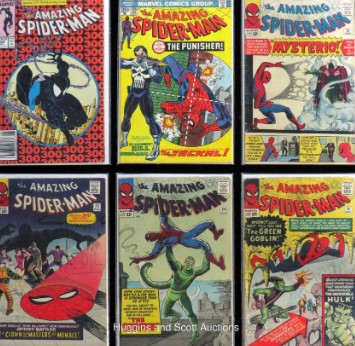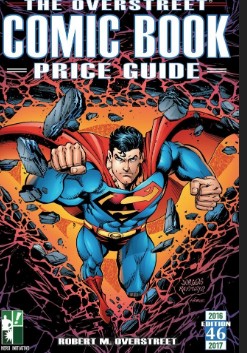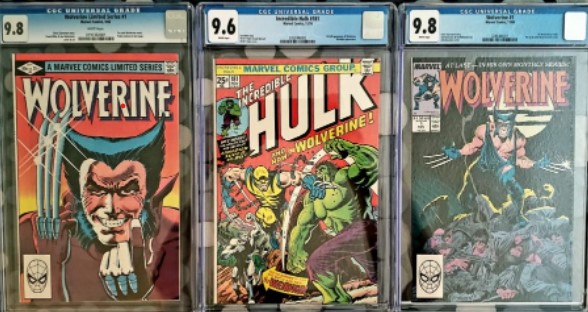Determining the value of a vintage comic book collection requires understanding several aspects of the books. These include the titles and significant of the issues, condition as well as current market conditions. Vintage comic books are generally considered those prior to 1979, so this article provides an overview of how to determine the value of your comic books from the golden age comics (late 1930s to early 1950s) to silver age comics (1955 to 1969) and the bronze age comics (1970-1979). More modern (recent) comic books also have potential value to consider. If you are looking to discuss your collection in more detail, you are always welcome to reach out to us to discuss.
Step 1: Understand which Key Issues are in your collection
 Key issues indicate comic books that have specific significance including the first appearance of a character, an important storyline or a classic cover. These issues are generally indicated in the Overstreet price guide with a short description of their significance and have correspondingly higher values than “common” issues. When estimating the value of the collection, it’s important to identify which comics are keys so you can make sure you are getting the proper value for those.
Key issues indicate comic books that have specific significance including the first appearance of a character, an important storyline or a classic cover. These issues are generally indicated in the Overstreet price guide with a short description of their significance and have correspondingly higher values than “common” issues. When estimating the value of the collection, it’s important to identify which comics are keys so you can make sure you are getting the proper value for those.
Many key issues feature introductions of characters who would go on to have long-running storylines such as the first appearance of the Punisher in Amazing Spider-Man 129 or the first Green Goblin in Amazing Spider-Man 14. Knowing the publishers such as Marvel (Spider-Man, Thor, Hulk, Doctor Strange, Iron Man, etc.), DC (Batman, Wonder Woman, Flash, Superman, etc.) and others will help you to understand which characters have more significance – many of the more prominent characters that appear in TV and films today had their start in vintage comic books.
Step 2: Evaluate the condition and estimated grades of your collection
 A key aspect of understanding the value of your collection is knowing which grades (conditions) the comic books are. In the Overstreet Price Guide , there are value listings ranging from GD (good) to VG (very good) to FN (fine) to VF (very fine) to NM (near mint). The better the condition of the book the more value it has. When evaluating the different grades of comics there are several factors to consider including completeness (does the comic have all the pages), structure (is the binding, cover and page in tact), wear (does the comic have color breaking wear)? In general, a Near Mint (NM) comic looks “like new” while the lower grades depend on the extent of the wear, while VF (very fine) condition comics have only slight wear and retain a high degree of color, gloss and structure. For vintage comic books (before 1975), it’s common to find average condition comics around VG (very good) condition. We can help you evaluate the condition more carefully based on a few pictures.
A key aspect of understanding the value of your collection is knowing which grades (conditions) the comic books are. In the Overstreet Price Guide , there are value listings ranging from GD (good) to VG (very good) to FN (fine) to VF (very fine) to NM (near mint). The better the condition of the book the more value it has. When evaluating the different grades of comics there are several factors to consider including completeness (does the comic have all the pages), structure (is the binding, cover and page in tact), wear (does the comic have color breaking wear)? In general, a Near Mint (NM) comic looks “like new” while the lower grades depend on the extent of the wear, while VF (very fine) condition comics have only slight wear and retain a high degree of color, gloss and structure. For vintage comic books (before 1975), it’s common to find average condition comics around VG (very good) condition. We can help you evaluate the condition more carefully based on a few pictures.
Step 3: Decide the type of value – complete collection or individual issues
Many collectors and owners of comic book collections have different goals for evaluating their collection. Some are hoping to understand the sale value to ensure they get a fair offer, while other collectors are hoping to better understand the current market values. In either case getting a sense of what value your collection has can help you better plan, organize and safeguard your collection. For larger comic book collections, it’s helpful to start with significant, key issues with value followed by the more “run” issues. Also, most common issues from the 70s to modern day have only modest value, whereas older key issues tend to be more coveted and scarcer, with higher values. Evaluating a larger collection can take more effort, and generally involves estimation of what are the significant comic issues as well as what are common “run” issues, while individual comic assessment for the key issues depends on the condition, rarity and popularity of a given issue.
Step 4: Determine if you want to have your comic books graded and certified
 Many long-time comic collectors evaluate whether to have their comic books graded or certified by a third-party. There are two major grading companies to consider – CGC Comics and CBCS Comics – both companies are reputable and will provide professional grading services. A few factors to consider in whether to grade your comics is the time and cost involved. Comic grading has variable costs depending on the value of the comics, and the turnaround time for grading depends on those tiers. In general, lower value books can take very long (up to 1 year) to get graded and will still cost 40 dollars or more per book to grade, while higher value comics can cost hundreds to grade with faster turnaround times. When grading many books it’s important to evaluate the total cost and timing of grading, and sometimes it’s more efficient to sell comics in ungraded (raw) format. Each collection owner should evaluate whether grading is right for them.
Many long-time comic collectors evaluate whether to have their comic books graded or certified by a third-party. There are two major grading companies to consider – CGC Comics and CBCS Comics – both companies are reputable and will provide professional grading services. A few factors to consider in whether to grade your comics is the time and cost involved. Comic grading has variable costs depending on the value of the comics, and the turnaround time for grading depends on those tiers. In general, lower value books can take very long (up to 1 year) to get graded and will still cost 40 dollars or more per book to grade, while higher value comics can cost hundreds to grade with faster turnaround times. When grading many books it’s important to evaluate the total cost and timing of grading, and sometimes it’s more efficient to sell comics in ungraded (raw) format. Each collection owner should evaluate whether grading is right for them.